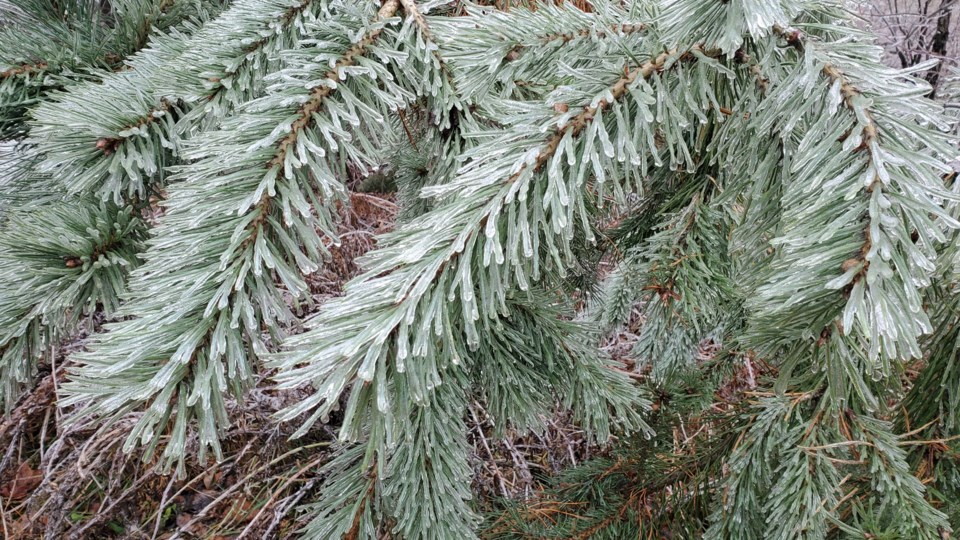The sounds heard outside the window were unmistakable ... big change was happening in the dark. The freezing rain had been beating against the pane for an hour and a substantial layer of ice had formed. A sudden reverberation of CRACK! Whoosh! THUD! filled our valley.
Somewhere out there, in the cold and dark night, another huge tree had come crashing down. At least the power stayed on, so no lines had been taken out. A sweep of the lane with the beam of a powerful flashlight revealed not a thing out of place. Hmm. Must have happened inside the woodlot.
A reconnaissance of the area the next morning revealed the mayhem. A very tall, very old and very thick weeping willow had busted in half, with the crown and all its associated branches now laying scattered in the stream, draped across the boulder fence and entwined with an ancient apple tree and formerly magnificent black cherry tree.
Although it had missed a footbridge, it completely blocked one of our walking trails. Cleanup is going to take a few days of my time.
This tree-snapping result of freezing rain is a common occurrence in our region, especially in the months of November and March. As the weather does its change over from rain to snow, and vice-versa five months later, ice is the result of this between-the-seasons transition.
By mid- to late-November most of the local hardwood trees have shed their leaves, except for a few species like red oak and willows. Bare branches can handle a waxing of ice but when thousands of still attached leaves get coated, the combined weight is more than the old tree can handle, and something has to give. SNAP!
Conifer trees such as white and red pine are also high on the casualty list, as those thick needles, which hang on year-round, have also accumulated a significant weight gain. Although conifer branches tend to be a bit more pliable than hardwood branches, there comes a point when the pines have to admit defeat and give up a few of their ice laden boughs.
All this snapping and cracking is actually a good thing, as a healthy forest has to be able to respond to a bit of adversity. The humans who manage trees call this process ‘natural pruning’ or even ‘natural thinning’. Although volumes have been written to guide forest managers with pruning and thinning operations, it is all just trying to emulate nature.
Within a healthy forest there is a constant competition for the elements of water, air, soil and space. The tree that succeeds in gathering the above elements has a pretty good chance of growing up tall and straight and eventually producing many seeds. But an early lead in growth may be scuttled by masses of secondary growth.
To attain that goal of ‘canopy tree,’ constant deployment of growth is a juggling act conducted by every great tree. With limited soil elements, a dry or wet year, crowding by these new comers, a tree has to make hard decisions. One of those is to close the leaf factories in places where photosynthesis and sugar manufacturing are no longer operating at peak efficiency ... the lower and now shaded branches.
By eliminating the maintenance of these nonproductive branches, all the available energies can now be sent to top and side growth. The now dead branches are slowly enveloped by an ever expanding trunk girth, eventually showing up as a knot in piece of lumber.
So what’s this got to do with ice storms? Good question. Guess I’d best get back to the topic at hand.
Back to that term ‘healthy forest.’ Nature’s plan for a healthy forest includes great diversity ... big trees, little trees, small trees, dead trees, trees that like the sun, trees that like the shade, and trees with holes in them. To achieve this type of diversity means that a little disruptive action is needed to shake things up and kick-start other cycles.
When the ice damaged tree falls down, or at least a portion of its branches, the penetration of solar radiation (OK, sunshine) increases and a lower level of growth now enjoys a period of renewed growth. Everything from mosses to wildflowers to tree seedlings now have a chance to achieve success in the botanical world.
Forest managers (like me) like to think that we are just duplicating nature when it comes to tree marking, pruning and thinning. And we are; just that we do it on a schedule that suits us rather than waiting for the next storm of the century to descend upon the woodlot.
The big willow that came crashing down last night has indeed created opportunity for the surrounding vegetation that have had to eke out a living under its impressive shade cover. Next year will be an exciting time to see what grows with vigour and even what new species may show up.
As Julie and I viewed the fallen willow and I began to verbalize the steps and time that will needed to clean up the tree, she looked at me and stated that this fallen tree was a gift. A gift? Yep, she says, now my retired husband has a project to keep him busy for quite some time!
With that said, she turned and wandered across the yard, picking up wind-blown sticks, leaving me to figure just how I was going to tackle the cleanup of this ‘natural disaster.’



